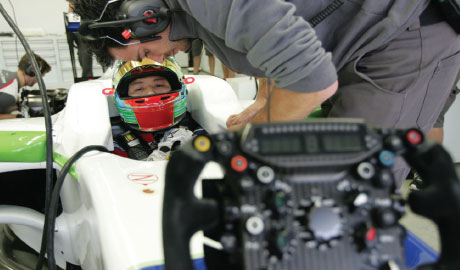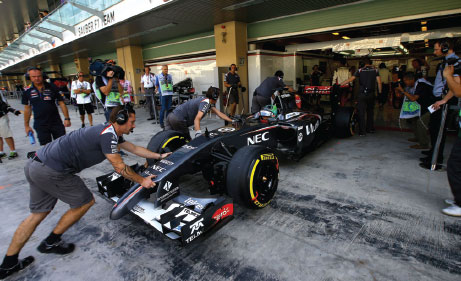Need for speed (and $200m)
Updated: 2015-02-10 09:40
By Andrea Deng(HK Edition)
|
|||||||||
Fong Cheun-yue's ambition is to be the first Chinese ever to make it to the F1 racing circuit. He might have a better chance if potential sponsors warmed up to the huge adrenaline rush of watching the sport, as he told Andrea Deng.
Adderly Fong Cheun-yue is just a step away from being the first Chinese ever to become a Formula 1 (F1) racer. All he needs is a sponsor who can put up at least $200 million.
Fong passed a 396-kilometer F1 trial last October, driving a Sauber C31 in Valencia, Spain. He drove 99 laps that day. His best lap time was an impressive 1 minute 14.885 seconds. "I am super thrilled," Fong said, his face burning with unrestrained exuberance. "The car is smooth and refined. I've never driven a car so balanced. It's like driving in a video game except for the 5G force (5 times normal gravitational force)."
Fong, 24, is one of only four Chinese people to have driven an F1, i.e. test-driven the vehicle and participated in an F1 practice. But none of the three Chinese drivers before him has found sponsors to join the racing circuit. Fong hopes to change that.
Securing sponsorship is not going to be cakewalk, but Fong is determined to keep at it. According to Formula Money, a publication that monitors budgets for F1, a top F1 team could spend up to $470 million a year, mainly spent on engineers, mechanics and research and development of the car design.
It's a business, not a pure sport, Fong said. F1 has the highest exposure, the highest return, yet the highest risk as well. A lot of the current racers are sponsored by big telecommunication or oil companies. Some drivers were kids of former F1 drivers, others are kids with wealthy fathers, willing to invest.
With eight years of racing background behind him, Fong dreams of being a national sporting icon and he is certain that this is the sport in which he wants to excel.
"It's not about who drives faster. It's about who makes the fewest number of mistakes. You make one mistake and chances are you've lost 0.3 seconds to your rivals. So you have to be extremely sensitive to how much power you give the engine. You can accelerate one meter too soon or one meter too late. Being able to judge for that one meter in 300 kilometers is very, very precise," said Fong.
"It ultimately boils down to competing in terms of "emotional maturity", says Fong. The driver best able to control his emotions at such a high-stress level wins.
High speed, high risk
During the 99 lap test drive in Spain, Fong's best lap time gave him an edge of only 0.013 seconds over Esteban Ocon, the reigning Federation Internationale de l'Automobile (FIA) European Formula 3 champion, who was also on the test track that day. Ocon is a highly-rated prospect for the Lotus F1 Team.
"Racing moments when you're really satisfied with your performance are limited. Very rarely does anyone come out perfect. When you get it right, the feeling is amazing. Everyone comes to you like you're a champion. When you're quick, everyone respects you and looks at you differently. There's huge satisfaction, and that is more than anything you can buy with money," he said.
The excitement of competition and potential rewards far surpass any fears about the lurking dangers of high-speed motorsports.
"I would say that it is safer than being a ballet dancer. It is safe - in a sense," said Fong.
For the most part, motorsports, particularly F1, require a phenomenal safety standard. But what could happen will happen, considering the extraordinary speed.
"For the long term it might have some impact on my health. But I'm not really smart to begin with," Fong joked.
During a Germany F3 race in 2008, a car ahead of him blew its engine. Oil spewed all over the track. Fong's car spun out of control on the oil slick, spewing smoke and blowing dust, propelled into the oncoming car unable to shun Fong's. Fong was concussed. He had to be medevacked by a helicopter.
Although it took him half an hour after he regained consciousness to be able to speak again, Fong left the hospital the next day feeling fine. He credited his quick recovery to his overall fitness.
An F1 car runs at an average of 200 km/h. "If it was a regular car that would be really fast. But in a race car you're sitting pretty low, and because you're concentrating, you don't really feel the speed. Actually you're accustomed to the speed," said Fong.
When an F1 car takes a corner at high speed, the gravitational force can reach 5G's - five times the normal gravity. By contrast, a Ferrari road car turning a corner at high speed generates only about 1G, or normal gravity. Drivers require great cardiovascular health, otherwise - as not enough blood goes to the brain - they would faint, Fong explained.
Inside an F1 car, a driver is tightly secured under six seatbelts, unable to take full, deep breaths. He has to hold his breath when the car turns a corner, until he gets back on the straightway.
"You're controlling 121 buttons on the steering, settings for the engine, gearbox, aerodynamics. Even a bit of humidity will make a difference. In a test drive, I used only seven or eight buttons - the brake, accelerator, radio, charge button, etc. In the meantime, the team looks at how many waltz of battery you can change while you're driving, because that changes the performance of the car, very slightly but enough to make a difference," said Fong.
Expensive sport
Fong began racing at 16, took third place in Formula V6, Asia in Zhuhai when V6 was the highest standard of auto racing in Asia.
He went to Europe in 2008, a gap year after finishing high school, and was racing in Germany in domestic F3. In 2009 he was admitted to Oxford Brookes University in Britain to learn motorsports engineering. He raced in the British F3 division until 2011. In 2012 Fong performed beyond everyone's expectations and won first place in the Audi R8 LMS Cup, competing against some of Asia's top drivers. He was able to obtain sponsorship from a Guangdong automobile company that covered his race expenditures from 2012 to early 2014, including the Le Mans 24 Hour Race.
After the test drive last year, Fong obtained the Super License issued by the FIA, which is one of the prerequisites to race in any F1 competition. He has networked with the Lotus F1 Racing Team and the Sauber F1 Team, essential to getting a racing spot.
In China, people are not familiar with the racing culture. The fan base is small, and there are not many potential sponsors, either. The Chinese Grand Prix, which takes place in the Shanghai International Racing Circuit annually, has been losing money since it opened in 2004.
"They don't quite understand motorsports and motorsports sponsorship, especially that it is a long-term investment," said Fong.
One of the companies he approached questioned why an F1 car was so costly, when "it weighs so little". Another told him that he would only be sponsored for a year. A driver's F1 career takes up to five years before the returns start kicking in.
"I'm looking for someone who could help financially and at the same time has passion for the sport. Like all sports in China, until you have a gold medalist, people don't invest," he added.
At one point the media wrote Ma Qinghua might become China's first motorsports driver to race in F1 in 2013, sponsored by a Wenzhou company. It didn't happen. Ma is out of F1 and has moved on to compete in other categories of motorsports.
Fong tries to keep his spirits up. His test drive last October and participation in an F1 practice last November were sponsored by a private Singaporean investor, a friend of a friend whom Fong met while watching the Singapore Grand Prix in 2013.
"Opportunities come to me unexpectedly. Nothing is certain. I won't die if I can't (participate in an F1 race). I think I could survive in other sorts of car racing. But if an opportunity arises, I'm ready for it," said Fong.
Contact the writer at andrea@chinadailyhk.com
|
Adderly Fong Cheun-yue understands that F1 test drive is just the first step of a long journey to become an actual F1 race driver. |




(HK Edition 02/10/2015 page6)
